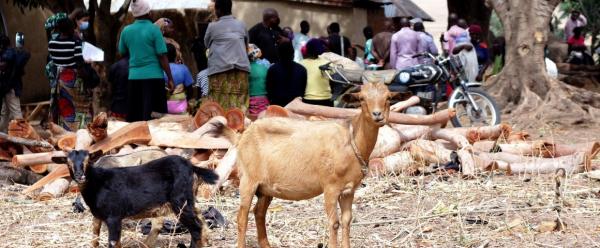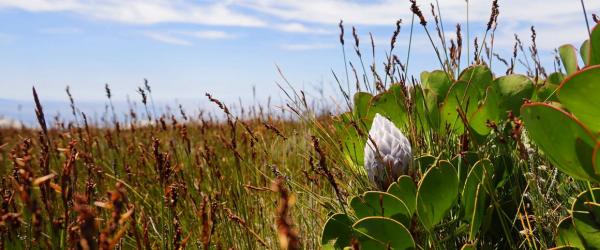Results & impact 28 October 2025
- Home
- CIRAD news
- News
- Seeds, farmers and biodiversity, Coex project
Seeds: when smallholder farmers shape biodiversity

A smallholder sowing his field in the Mboro region, Senegal © R. Belmin, CIRAD
How do smallholder farmers source seeds, how do they use them and for what purposes? Coordinated by CIRAD and financed by Agropolis Fondation, the CoEx flagship project has set an ambitious objective: studying the different seed management practices in West Africa. The results, which were presented on 11 May during a webinar to conclude the project, pave the way towards fairer agricultural policies that are conducive to greater biological diversity, but also to a more diverse range of contexts and stakeholders.
Climate hazards, price volatility of agricultural commodities, diseases, etc. According to Sélim Louafi, a researcher in political science at CIRAD and co-coordinator of CoEx, “rural societies partly owe their resilience to the biodiversity found in the field. Improving possibilities for access to seed will therefore increase the solutions available to address different risks”.
For more than four years, the French, Canadian and West African partners involved in CoEx studied the diversity of cultivated plants in Senegal, Mali, Burkina Faso and Niger. In total, 32 species were examined, including sorghum, millet, maize, groundnuts, cowpeas, okra and onions. More than 500 smallholder farmers were interviewed and discussion groups were opened in almost 150 villages.
Seeds: at the crossroads of biological and cultural diversity
The first focal area of the CoEx project highlighted the different seed strategies at the local level. Far from being considered as simple biological resources by smallholders, seeds are seen as the product of a multitude of individual and collective life experiences.
Heritage, rites, adaptation to climate change, response to market demand, etc. The needs and expectations of smallholder farmers thus shape what researchers call “cultivated diversity”.
“Cultivated diversity represents not only the species and varieties chosen by smallholder farmers, but also the social dynamics that motivate these choices”, says Hélène Joly, a geneticist at CIRAD. “The use of a particular seed is thus a political and social issue, rather than a purely biological one”.
Christian Leclerc, an ecological anthropologist at CIRAD, continues: “On average, the number of cultivated species per village was 17. But this figure fluctuated according to how long the village had existed, the number of languages spoken, or the number of farmers belonging to a farmers’ organisation, for example. We identified more than 10 sociocultural factors that influence the number of species per village”.
Translating the complexity of local strategies into policy terms
“The national legislations focus only on seed transactions in the industrial and commercial sector, in other words the ‘formal’ sector. Yet other forms of organisation are observed in the seed networks used by farmers”, says Sélim Louafi. “The terms ‘alternative’ or even ‘informal’, used to characterise these networks, mask a wide range of practices governing the supply of seeds and the management of cultivated diversity. These are the practices we wanted to highlight at the regional level. The goal was to improve public policies to ensure they correspond to the reality on the ground”.
The researchers thus identified the regional trends for the main seed supply methods: on-farm production (41 %), markets (40 %), followed by gifts-exchanges (14 %) and NGOs (5 %). However, these figures do not reflect the significant variability of practices, for example according to the species or the context.
Developing a more inclusive legislation
Laws and regulations often coexist with more “informal” rules, in particular those governed by custom. In West Africa, the diversity of seed management practices thus translates into a multitude of “standards”, whether legally formalised or not.
One part of the project focused on these legal and economic aspects. Who participates in the development of rules, how do they change them, and for what purpose? The goal is ultimately to align this multitude of rules and practices, ensuring maximum stakeholder participation in decision-making.
Research is far from neutral in the debate on access to seed
To conclude, the project focused on the practices of research organisations. Indeed, these organisations play a role in the production of knowledge, but also in access to seed, particularly through gene banks.
To this end, CoEx associated seven farmers’ organisations in West Africa and France with 11 French and West African research laboratories. “We needed to use our own research methods to express the ambition of devising public policies that take account of the full diversity of needs and experiences of smallholder farmers”, says Mathieu Thomas, a geneticist at CIRAD and co-coordinator of CoEx.
“Research is not neutral in its role as a stakeholder in this debate on the diversity of seed systems”, adds Sélim Louafi. “CoEx has examined this role in order to remedy the inequalities typically observed, both in the research partnerships between farmers and scientists, and in the governance systems of gene banks”.
The lack of cooperation between research institutes and farmers’ organisations is sometimes a source of mistrust. The CoEx experience has nevertheless demonstrated the full value of exchanges for both parties. The members of the project hope, for example, that these lessons will bring about changes in the management practices of gene banks, for more open collaborations with farmers’ organisations.
.................................................................................................................................................................................
A manual for a fair collaboration between scientists and smallholders
Non-equitable relations, administrative obstacles to resource sharing, tensions, etc. The research institutes are often poorly equipped to work with farmers’ organisations. CoEx thus sought to establish itself as a living laboratory of new practices that are fairer and more collaborative. This process led to the production of a manual of recommendations to improve their relations. Challenging conventional wisdom, opening areas for discussion in which smallholders and researchers feel comfortable sharing information and skills, etc. This manual ultimately contributes to enriching research, while legitimising the knowledge and expectations of farmers’ organisations.


